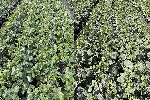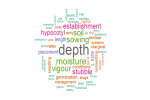-
 Biosecurity, 02 May 2025
Biosecurity, 02 May 2025Essential tips to start and keep going
A farm biosecurity plan is an essential investment in your farm’s resilience, productivity and reputation. It extends beyond individual farms to benefit the broader Australian agricultural sector, economy, environment and society.
-
 Biosecurity, 17 Apr 2025
Biosecurity, 17 Apr 2025Healthy seeds crucial for successful winter sowing
Infected seeds can introduce hidden threats, so securing clean, healthy seeds is crucial to protect your farm from pests, diseases, and weeds
-
 Biosecurity, 25 Mar 2025
Biosecurity, 25 Mar 2025Integrated approach to pests on-farm
To ensure pest control strategies are effective, it is crucial to diversify the approach taken and reduce reliance on any single chemical. Integrated pest management (IPM) offers an integrated solution by incorporating a variety of non-chemical control methods, mitigating the potential impacts of changes in pesticide availability while still effectively managing pest populations.
-
 Biosecurity, 24 Mar 2025
Biosecurity, 24 Mar 2025Eyes on exotic pests
Despite Australia’s stringent pre-border and border controls, exotic pests still pose a threat. Early detection of these pests is vital in preventing outbreaks that could disrupt the grains industry and other agricultural sectors.
-
 Biosecurity, 04 Dec 2024
Biosecurity, 04 Dec 2024Farm biosecurity needs vigilance
Taking steps to understand, prevent, and deal with pests, weeds and diseases is crucial for biosecurity on farm
-
 Biosecurity, 27 Nov 2024
Biosecurity, 27 Nov 2024Do not let this stink bug hitch a ride
Not present in Australia, the Brown marmorated stink bug (BMSB), (Halyomorpha halys), poses a significant biosecurity threat, particularly between September and April. When temperatures drop in winter, it seeks shelter in cars, shipping containers, houses and even inside luggage and clothing and is an expert hitchhiker. With the potential to affect over 300 different plants and crops, understanding and preventing its entry into Australia is crucial for protecting the agricultural industry.
-
 Biosecurity, 04 Nov 2024
Biosecurity, 04 Nov 2024Insect control and effective fumigation help guard your harvest
As pests such as weevils and other stored-product beetles become less susceptible to phosphine, there is growing concern over its future effectiveness as a primary fumigant for stored grain in Australia.
-
 Biosecurity, 21 Oct 2024
Biosecurity, 21 Oct 2024New grains biosecurity officer for Queensland
The Grains Farm Biosecurity Program (GFBP) has welcomed Adam Jalaludin as the new grains biosecurity officer (GBO) for Queensland. He will based at the Queensland Department of Agriculture and Fisheries in Toowoomba. Adam Jalaludin will work to enhance biosecurity preparedness and management at farm and industry levels, contributing to the resilience of the state’s $2 billion grains industry
-
 Biosecurity, 08 Aug 2024
Biosecurity, 08 Aug 2024What do you need to know about barley stripe rust?
Barley stripe rust (Puccinia striiformis f. sp hordei) poses a significant threat to wheat and barley production globally. Although not present in Australia, our grains industry is going to great lengths to keep this damaging disease out. Barley stripe rust is a fungal disease and is known to reduce plant and root growth, increase water loss and cut, resulting in fewer and lighter kernels.
-
 Biosecurity, 06 Aug 2024
Biosecurity, 06 Aug 2024Consider biosecurity at field events
Field days, trial inspections and crop tours provide growers, agricultural professionals and extension workers with the opportunity to learn about new farming techniques, technologies and varieties. However, these events also pose potential biosecurity risks due to the movement of people, machinery, vehicles and other materials. To reduce risk, consider the following measures.
-
GRDC News
+
GRDC News

Project delves into water repellent soils
A new research project exploring management options for soil water repellence will support Australian grain...

Queensland on the pulse with mungbean breakthrough
Queensland’s mungbean industry is set for a major boost with the launch of two new...

Industry consultant honoured with GRDC award
The 2025 northern GRDC Seed of Light has been awarded to Independent Consultants Australia Network...

Victorian agronomist and scientist each win grains award
Agricultural consultant Cam Nicholson and research scientist Dr Audrey Delahunty each received awards this week...

Acid soil research priorities identified
A National Soil Acidity Workshop held in Adelaide in February has identified and prioritised transformational...

GRDC regional Updates to kick off in Cunderdin
Western Australian grain growers can learn about the latest research and innovations relevant to their...

New sowing date calculators could lift wheat, barley yields
The Grains Research and Development Corporation (GRDC) has made a significant investment in the National...

Automated biosecurity sentinels guarding the modern farm
GRDC’s role in the recent $21 million investment in the iMapPESTS project marks a significant...
ADVERTISEMENT -
Agronomy
+
Agronomy

Request the data
When considering new varieties, requesting independent data is important.

Impact of NVT extends beyond variety selection
The National Variety Trials (NVT) system adds value to the agricultural research pipeline in ways...

Advancing cereal yield frontiers
GRDC is investing in research to identify agronomic tactics to help growers achieve yield potential,...

The nitrogen bank for higher yields and lower emissions
Analysis of the impact of nitrogen decision-making systems indicates that yield does not need to...

Frost research set to target ear architecture
After many years of hearing stories about wheat varieties with different-shaped ears being more tolerant...

Cell membranes key to promising frost approach
The ability of plant cell membranes to flex instead of breaking or bursting at low...

To plant, or not, on late summer rain?
Higher returns are possible from a farming system that can flexibly optimise sowing opportunities throughout...

Managing waterlogging is a long road travelled
Working with South Coast NRM on a GRDC-supported National Grower Network project, the Marold family...

World-first solution to combat spray drift saves growers time, money
The Weather and Networked Data (WAND) system, a pioneering Australian-developed weather data technology, has been...

Waving a WAND to boost spraying certainty
The Weather and Networked Data (WAND) system allows growers to plan their spraying operations with...
ADVERTISEMENT -
Grower stories
+
Grower stories

Winter season starts
Every year, GroundCover™ tracks a group of growers throughout Australia as they navigate the cropping...

Time to reflect as growers weigh up mostly positive harvest results
Grain growers from across Australia report on how the season is progressing as they gear...

Lessons aplenty in levelling
The benefits of levelling melon holes were discussed when the Yarrie Lake Landcare Group travelled...

Opportunity knocks for mungbeans this season
Mungbeans have been exceptional this season for south-eastern Queensland growers Peter and Kylie Bach, with...

Futureproofing weed management
Data for future weed solutions is being collected by Terry Antonio and his SwarmBot

On-farm advocacy prompts national project
Trials testing long coleoptile wheat have had an unexpected benefit, showing that deep sowing can...

Agile ‘moisture farmer’ turns flood pain into flood gain
A Victoria grain and sheep producer takes the good with the bad when floods arrive,...

Winter canola proves profitable at Weatherboard
Ben Findlay’s farm near Weatherboard, Victoria, utilises ungrazed winter canola, specifically the hybrid RGT Nizza...
ADVERTISEMENT -
Weeds, pests and diseases
+
Weeds, pests and diseases

Trials target spiny emex
Investment by the Grains Research and Development Corporation (GRDC) has investigated opportunities to expand lentil...

The future of the double-knock
An expert in weeds management has outlined a potential approach for dealing with glyphosate and...

Growers warned of increased mouse activity
The National Mouse Group warns of increased mouse activity reports in the Darling Downs and...

Extreme weather challenges RLEM management
Extreme fluctuations in weather patterns in 2024 highlighted the difficulties in protecting crops from pests...

Effective stripe rust management starts with variety selection
Random surveys across the northern region demonstrate the power of growing wheat varieties with in-built...

App helps mungbean growers manage powdery mildew
The PowderyMildewMBM app has been helping mungbean growers across Queensland and New South Wales better...

Essential tips to start and keep going
A farm biosecurity plan is an essential investment in your farm’s resilience, productivity and reputation....

Healthy seeds crucial for successful winter sowing
Infected seeds can introduce hidden threats, so securing clean, healthy seeds is crucial to protect...

Herbicide-tolerant lentils: Registration and impacts
The rise of lentils as the most profitable crop in southern rotations was enabled by...

Grains industry scores A-plus for chemical residue compliance
Australia’s grains industry has a 99.2 per cent compliance rate with national maximum residue limits...
ADVERTISEMENT -
Crops
+
Crops

Hardy barley proves its worth in rotation trials
Long-term farming systems experiments support barley as a profitable inclusion in canola and wheat rotations

Award-winning crop takes topsy-turvy seasonal conditions in its stride
Minhamite grower Tim Whitehead has won a GRDC Hyper Yielding Crops initiative award for his...

Overcoming acid soils
GRDC has made a strategic investment in the National Lentil Breeding Program to enhance the...

SA research push to close pulse yield gaps
Increasing herbicide resistance in broadleaf weeds, particularly due to Group 2 imidazolinone (IMI) herbicides, is...

Understanding canola establishment to optimise yields
Establishment of any crop is foundational to its performance and, ultimately, its yield. A major...

Enquiring attitude opens opportunities
Have-a-go attitude is surprising Chloe Rout in the avenues and opportunities it can open for...

Brainstorming with other growers a path to progress
Minhamite grower Tim Whitehead has won a GRDC Hyper Yielding Crops initiative award for his...

Decline in wholegrain bread
Australian Dietary Guidelines recommend that Australian adults eat six servings of grains daily, preferably as...
ADVERTISEMENT -
Innovation
+
Innovation

Autonomy proves a game changer
Speaking at a GRDC/Society of Precision Agriculture Australia webinar, Tom Longmire said a SwarmFarm robot...

Are you ready for autonomy?
With automated on-farm solutions for farm tasks now available, it is worth considering if you...

Software breakthroughs powering new genetic discoveries
With GRDC investment, Analytics for the Australian Grains Industry (AAGI) has developed CoreDetector, a software...

Drought-tolerant crop research
A canola variety modified to tolerate the herbicide glyphosate has been placed on the Office...

Grains steps up preparations for GHG monitoring
With the grains industry, like agriculture more broadly, facing increasing pressure to know its carbon...

Fostering high-impact innovation in heat tolerance
GRDC has long maintained an extensive investment portfolio looking to improve the heat tolerance of...

Vale Alan Robson – a champion for agricultural science
Alan Robson, foundation director of the Cooperative Research Centre for Legumes in Mediterranean Agriculture, has...

Research enthusiast sees value in ground-truthing
Seven years ago, a forward-thinking mixed farmer from southern New South Wales applied to become a...
ADVERTISEMENT -
Farm business
+
Farm business

Business structure helps map the succession path
Judy Wilkinson draws on a wealth of personal and professional experience to guide people through...

Talk early and often
Rutherglen grain grower Andrew ‘Russ’ Russell provides an insight into his succession experience and the...

Ten tips to reduce the risk of harvester fires this season
Recent GRDC Harvester Set-up Workshops run across Australia’s grain growing regions have highlighted the importance...

Selecting grain protectants this harvest
GRDC's latest cereal protectants offer enhanced pest management. Key for growers: rotating Spinosad, Deltamethrin, Fenitrothion,...

Seeds need cool, dry conditions, no matter the variety
As investment in on-farm storage grows, new research shows why it is critical to maintain...

Give grain storage a pre-harvest health check
GRDC Grain Storage Extension team project lead Chris Warrick said the biggest challenge of storing...
ADVERTISEMENT